Latest posts.
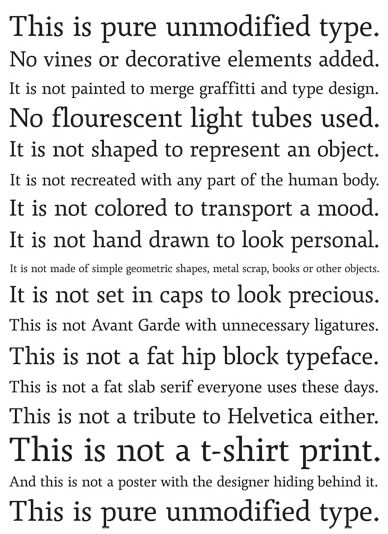
http://farm4.static.flickr.com/3212/2739457894_2b10257c23_o.jpg
above: ‘This is pure unmodified type. No vines or decorative elements added. It is not painted to merge graffiti and type design. No fluorescent light tubes used. It is not shaped to represent an object. It is not recreated with any part of the human body. It is not colored to transport a mood. It is not hand drawn to look personal. It is not made of simple geometric shapes, metal scrap, books or other objects. It is not set in caps to look precious. This is not Avant-Garde with unnecessary ligatures. This is not a fat, hip block typeface. This is not a tribute to Helvetica either. This is not a t-shirt print. And this is not a poster with the designer hiding behind it. This is pure unmodified type.’
Posted on December 13th, 2008.
Categories: Favorites, Inspiration, Research, Theory.
...................................................................................................................................
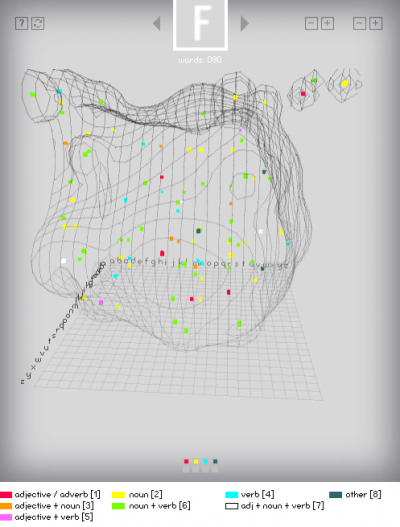
http://toxi.co.uk/p5/base26
Because four-letter words have a special status in the English language and culture ‘base26′ was done to give an overview of (almost) all English four-letter words and to visualize their relations to each other.
Each point is a presentation for a four-letter-word with a position based on 4D coordinates for x,y,z and time. The colors indicate types of words and the wireframe surface depicts the frequency of occurence of letter combinations. (toxi.co.uk/p5/base26)
Posted on December 12th, 2008.
Categories: Generated, Processing, Programming, Research.
...................................................................................................................................
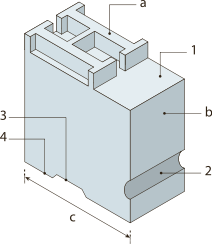
http://upload.wikimedia.org/wikipedia/commons/e/e9/Metal_type.svg
On the 21. of March the CCC published a conversation with Thomas Maier on the history of typography at a glance. Starting with the early evolving of script and the application of copper engraving Thomas Maier exemplifies the invention of book-printing and Gutenberg’s printing technique. Moreover he talks about technical specifications and about some related topics like copyright and standard paper formats. He later describes the transition from using Line-setting systems to the usage of punched tape, telegraphic systems and typewriters and further the offset print and Phototypesetting. Finally he comes to the chapter of digitalized fonts.
From 1900 on it was just when the variety of type-designs grew with the replacement of the lead and not before 1965 the script became digital while Photocomposition was the latest font-setting technique. Through photo-scans fonts could be fragmented into multiple points. One of the first systems for that was Rudolf Hell’s ‘Digiset’. In 1975 Fonts got described through digital data with the help of the Ikarus-system. Originally this system was used to cut letters with a cutting machine to achieve stencil-like films for Phototypesetting.
Here letters could be described through Bezier curves by defining the position and kind of each point on the letter-shape and this input data was then stored on punched tape. This technique enabled the calculation of bitmaps from vector images which could be directly applied to the Photocomposition. From this approach later in the 80ies PostScript evolved.
Nevertheless Thomas Maier sees the decisive turning point for the development towards digital font in automated punch-cutting via a pantograph during the industrial revolution. For the first time script was seen as being specified by its contour. Before that a letter was ‘a plane thing’, with punch-cutting the translation of the line that was to mill defined the shape. This view was required to invent Linotype and the digitalizing for the Ikarus system.
In the 80ies a combination of corporate activities result in the development of a series of font formats. Apple introduces the personal computer, Adobe implements the programming language PostScript for the description of site contents such as format, graphics and font. Later Adobe releases PDF, Aldus designs Pagemaker and with its release establish Desktop Publishing. Eventually Linotype supplies a driver for PostScript.
Because of Licensing Apple develops a own font format which technically and mathematically was akin PostScript and that lead to the release of the TrueType format Type 1. Then some more TrueType formats and Opentype were to follow before PostScript finally became open source.
Opentype is unique as it has a two-way method to treat script. For the first time character and glyph, i.e. meaning and form, were seen as independent. This made a range of micro-typographic issues such as ligatures possible.
Posted on December 11th, 2008.
Categories: Research, Theory.
...................................................................................................................................
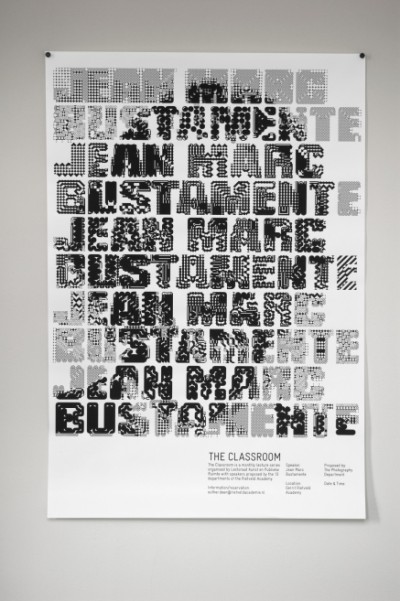
http://www.jonathanpuckey.com/projects/the-classroom/resources/cl-jeanmarc1.jpg?thumb=36ee3320b8a1cee832f900f8daca118b
Amsterdam based digital designer Jonathan Puckey created some own tools for his various works around type and text. Amongst his used media is Scriptographer that I mentioned before.
Posted on December 11th, 2008.
Categories: Poster, Research.
...................................................................................................................................
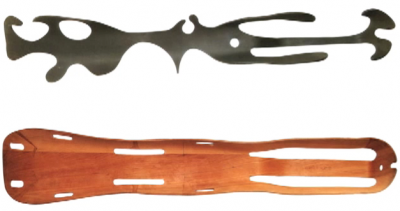
http://www.ted.com/index.php/talks/tim_brown_on_creativity_and_play.html
Last month TED posted a video of Tim Brown’s presentation on the link between creativity and play.
The approach he pictures seems very important to me and the problems he explains I experienced before. With my thesis project - as I intended to do a work that needs to include play as a decisive part of the process I put myself in a somehow vulnerable position because play and imperfectness tend to be seen as the contrary to profession. And in most schools, businesses and graphic design platforms profession gains the most respect…
Tim Brown says the reason because many adults can’t be playful easily is the fear of failure or bad critique. Compared to children grown-ups loose the freedom and trust in their environment and tend to conservative thinking. But designers need to play and therefore to take risks. So this makes it very important for them to act in an environment they can trust. Playfulness is important because it eases the process to come up with creative ideas, it opens opportunities and supports productivity. There are three main categories of play: exploration, construction play and role play.
Exploration is about quantity. A classic example is to look for as many usages for a paper-clip as possible. It is about forgetting the original goal but exploring what is interesting for one. But as this behavior is against adult habits we have to relearn openness and playfulness and it does not make sense to introduce rules to break the rules such as brainstorming guides. Experiments explore possibilities and also physical objects.
Construction- or building-play means thinking with ones hands and is very effective and useful for production stages like rapid prototyping. It helps to communicate about a specific product or such when you have a dummy to talk about even when its just taped together from random things from around the work-space. Here it becomes obvious that another obstacle for adults remaining playful is that all kind of ‘play-tools’ get lost in schools with each level of school.
Role acting is another way to experience your environment and one can simulate case studies or play through scenarios.
Adults are very reluctant to engage though. This is partly embarrassment again or they don’t believe that what emerges is necessarily valid. The social scripts kids follow in role plays show that it is worth taking serious and adults experienced many situations throughout their lives so that they have a huge set of role play scripts already internalized - so we are very good in acting out an solution. Another aspect is that it facilitates to imagine a specific surrounding one is designing for. Besides simulation you could do role play in the real world as well. By documenting an experience you are going through even unintended emphasis happens on specific aspects you might have not noticed before.
Eventually Tim Brown stresses a few points about play:
Play is not anarchy. (Play has rules, especially group play)
There are rules about when to play. (There should be transitions between experiences)
In design one goes through two distinctive modes of operation - the generative mode and the creative mode (exploring and creating)
You can be playful and professional/serious at once
Posted on December 9th, 2008.
Categories: Methodology, Research, Theory.
...................................................................................................................................
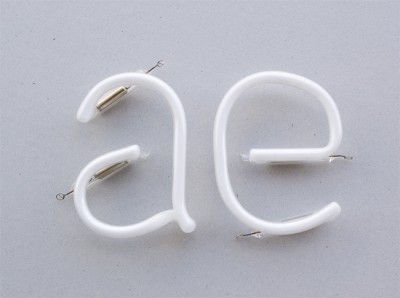
http://www.clementgallet.com/archive/print/afterwork2/02.jpg
Clement Gallet collaborated with a neon constructor to design a digital font, ‘afterwork’, from a neon type sample. He translated the typical forms of the shaped material into letters.
Posted on December 9th, 2008.
Categories: Research.
...................................................................................................................................
End of November the first non-beta version of Processing (1.0) got released. With it I am using the latest version of Geomerative now (ref 19). Ricard Marxer was so kind as to provide additional functions for me so that I could translate some
fundamental functionality from my previous code.
The preceding versions have features though that I appreciate and that’s why I will keep working with them. Intersection works well and contours have no closure - essential aspects when line-drawing.
Font-metrics and -formatting seem still be some rare topics among programmers. I can apply kerning by bringing in the kerning-pair information out of the metrics file of a font. And I did some very basic alignment for body text that suits my needs. At the same time Christian Rieckoff was working on automatic line-breaking in java what might be worth a bookmark for future plans. (texone.org/?p=43)
Christian Rieckhoff educates at the UDK Berlin and held a Processing course on digital fabrication in Summer in which he provided some very helpful code examples.
Posted on December 7th, 2008.
Categories: News, Processing, Programming, Research, Resources.
...................................................................................................................................
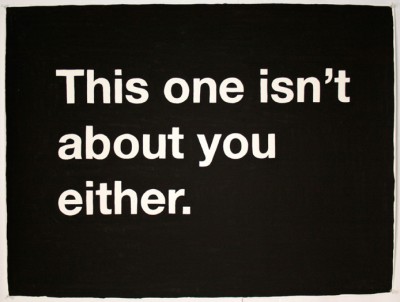
https://www.beholder-art.com/img/dynamic/artist/artwork/large//783.phpvjBOcF
The drawings of Mike Monteiro are mainly achieved with black gouache painted texts on white paper. His words seem very much like thoughts you easily can identify with or which draw scenes or emphasize the multiple semantics of words when separated from their context.
Posted on December 7th, 2008.
Categories: Research.
...................................................................................................................................
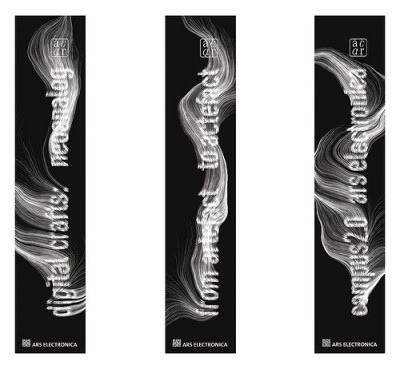
http://farm2.static.flickr.com/1326/1151971874_6d3bb7a0fa.jpg?v=0
The Swiss Leander Herzog created a broad range highly inspiring and visually appealing designs mostly implemented with processing. He also digitally fabricated certain pieces and experimented with a drawing machine. Moreover he applied code to font design akin the banner title for the ‘ars electronica’ in 2007.
Posted on December 7th, 2008.
Categories: Favorites, Generated, Inspiration, Processing.
...................................................................................................................................
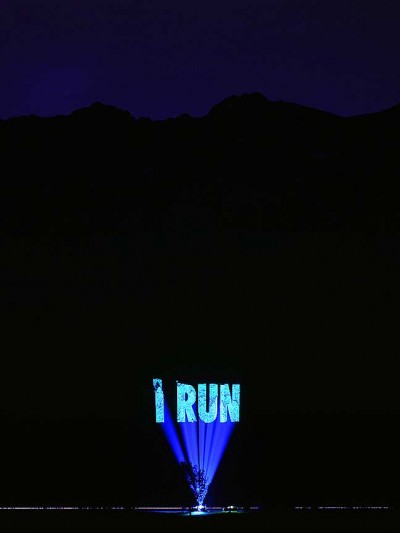
http://www.pbs.org/art21/slideshow/popup.php?slide=1475#
Jenny Holzer’s medium is writing. Wheather it is street posters, LED, projections or everyday objects like T-shirts or cups.
The artist’s writings are truisms, sayings, various statements appearing as poetry-like phrases. But Holzer clearly distinguishes her art from poetry or literature in general because ‘it has to do with the demands of the medium on which I place it.’ By applying media that is commonly used in advertising she found a way to communicate explicit statements about society in a minimalistic manner and to question how those media affect information.
With Xenon light she is also able to create large environmental projections on buildings or landscapes.
Until New Year 2009 the Guggenheim in New York as well features Jenny Holzer’s work on the outstanding facade of the museum.
www.guggenheim.org/new-york/exhibitions/on-view-now/for-the-guggenheim
An example of her usage of online media is ‘please change believes’ where you can edit and contribute truisms. adaweb.walkerart.org/project/holzer/cgi/pcb.cgi
Posted on December 3rd, 2008.
Categories: Installation, News, Research, Theory.
...................................................................................................................................








